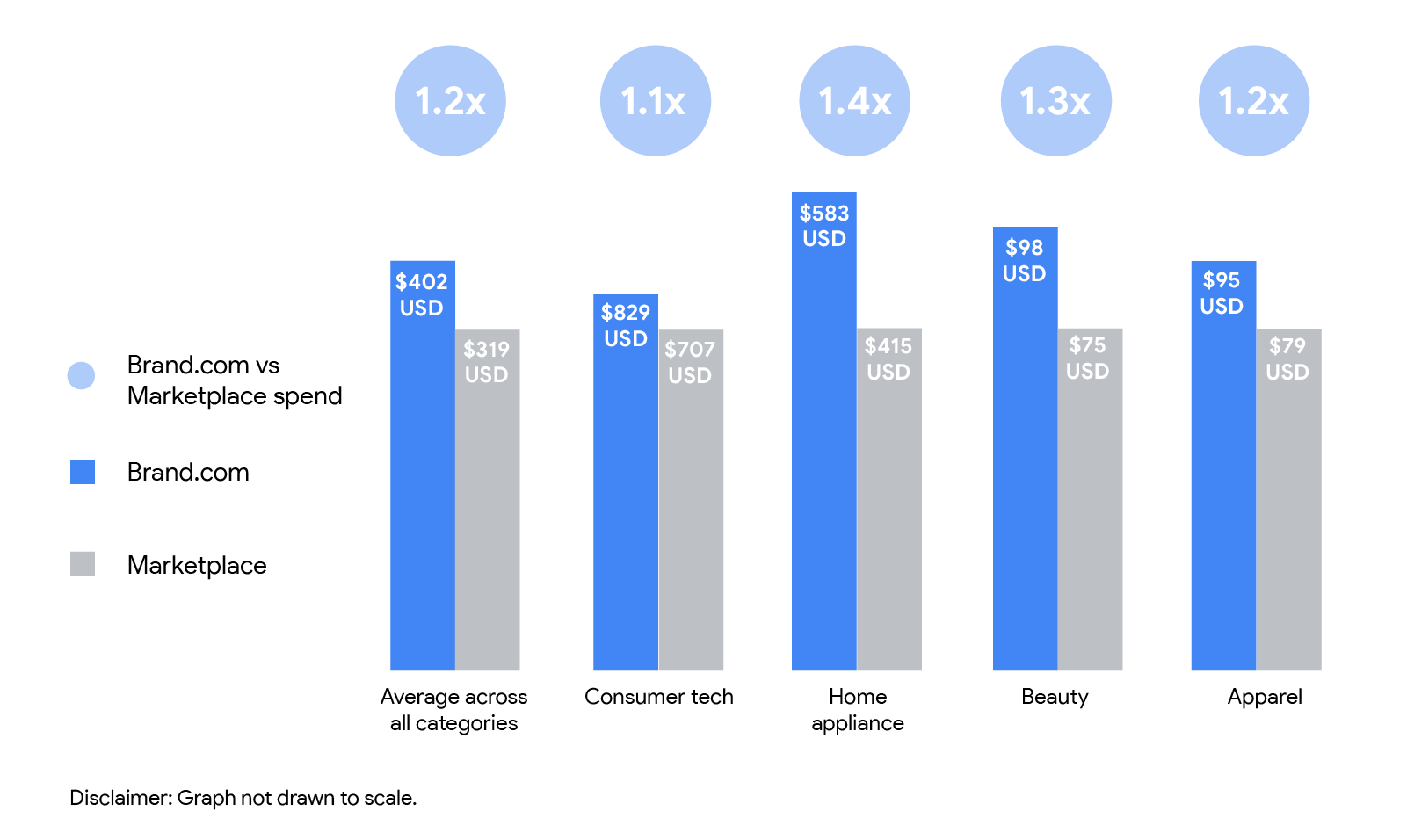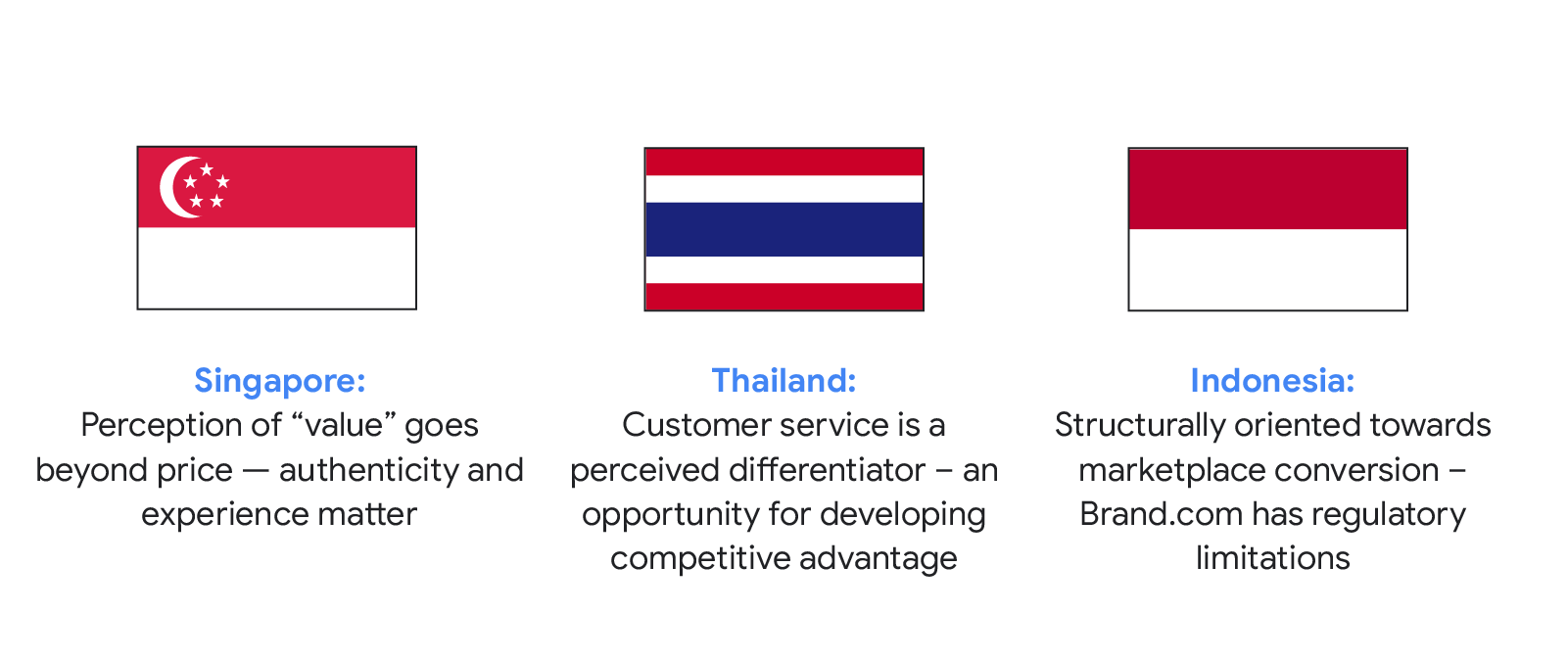For retailers, 2020 was a year of accelerated digital adoption. With restricted movement and people spending more time at home, consumers turned to digital to meet more of their everyday needs. Now, with many people using digital services for the first time — and more than 90% of users saying they will continue to use these services in the future — it’s more important than ever for brands to invest in a digital presence.1
In our research of both brand websites (Brand.com) and marketplaces in Singapore, Indonesia, and Thailand, we discovered the significance of the roles of each platform in consumers’ paths to purchase across verticals such as consumer electronics, home appliances, apparel, sportswear, and beauty products.
We learned that 55% of shoppers used a brand’s website at some stage during their path to purchase, indicating that Brand.com is an invaluable channel in consumers’ buying journey, alongside marketplaces.2

In our study, we found that people expressed strong intent to continue using Brand.com in the future.3 So, now is the time for brands to focus on adopting a robust direct-to-consumer strategy to establish a holistic online retail presence.
Here, we unpack three key insights from our research that show why Brand.com is critical to a brand’s online success and how marketers can build a robust Brand.com strategy.
1. Shoppers want an immersive experience that helps them explore products in detail
In this past year, because many people have not been able to visit retail stores due to pandemic restrictions, more and more consumers have turned to brand websites to explore products and services.4 This is an opportunity for brands to create a unique, personalized brand experience on their website. This gives them an edge in offering experiential shopping because they can create a frictionless experience for customers, with everything from interactive ways to explore their products to videos and images that clearly outline product details and pricing.
Around 41% of Brand.com shoppers indicated that brand websites give them an immersive experience, and these shoppers are motivated to use these websites because they offer clear product specs, show product specs via photo or video assets, and are easy to navigate. Buyers also indicated that they are motivated to use Brand.com because it offers a way to compare products from the brand.5

“I enjoy looking at all the images on the [consumer electronics brand] website. I think I went to the website several times — maybe four times — to see if there’s an emotional connection with the product. That was the day I thought, okay, I’m just going to get it.” — Singaporean Brand.com shopper
As brands think about their Brand.com, it pays to look at the customer experience from different angles. Inconsistent experiences across platforms or changes between desktop and mobile views can result in a subpar customer experience.
2. Shoppers turn to Brand.com for a sense of assurance on their purchase decisions
When shopping on a brand website, 42% of shoppers said they felt the product they were purchasing was trustworthy or authentic, while 41% said they were assured that the information on the website was correct.6 Brand.com also allows customers to directly communicate with the brand for after-sales customer care and service.

Consumers are also using brand websites to make more informed purchase decisions. In our research, 69% of shoppers use Brand.com to look for better pricing or promotions. Price-sensitive shoppers then prefer to make their purchases on marketplaces because of special deals or discounts.7 These promotions are often rated as the top reason why consumers choose to shop on marketplaces over a brand website.
With the right strategy, brands have the opportunity to offer more value-added services to build better, long-term relationships with their customers, such as extended warranties, flexible return policies, shipping deals, or “refer a friend” promotional codes.
“When I compare prices, Brand.com is sometimes 2-3% more expensive than marketplaces, but for the 14-day change-of-mind return policy it offers, it’s worth it.” — Singaporean Brand.com shopper
Driven predominantly by these additional brand services and add-ons, according to our survey, consumers say they are willing to spend 20% more on an average order when making purchases on Brand.com.8
Average spend across categories

3. Shoppers want to connect with brands on their terms
When it comes to Brand.com, consumers want localized content, from ensuring content is in a language they are familiar with to being able to find and buy products they’ve viewed online via local brand websites.
For non-English speaking markets, local-language options can contribute to a greater sense of trust and reliability. We found a key barrier for non-buyers to discover more about products was that a brand website was in a foreign language, making it difficult for shoppers to learn more about a product or delivery options.
At the same time, localization also ensures products available in-market are listed online (not just found in-store), while providing local warranties for people purchasing from overseas retailers can also help instill confidence in your brand.
“For consumer electronics, I am quite serious about buying them from Brand.com. If I buy a product directly from the brand’s website, I feel more confident. I am sure that you should be able to claim if there are any issues and the products delivered will definitely be brand new and in good condition.” — Thailand Brand.com shopper for consumer electronics
With this in mind, a localized strategy is essential to stay relevant with shoppers, but make sure you’re curating for each market.
The roles and opportunities of Brand.com vary across SEA markets:

With Brand.com, brands are building a first-party data ecosystem, which can help personalize and localize the experience shoppers crave. By engaging the right customers and finding ways to continually connect with them, brands are future-proofing their brand and ensuring long-term value.
It is critical for brands to fully invest in a balanced digital presence that includes Brand.com. Shoppers want to be able to discover, research, evaluate their options, and make their purchase seamlessly. And as our research reinforces, Brand.com plays a crucial role throughout these consumer journeys. For online retail success, owning and building customer relationships through Brand.com will be key to the future growth of business.
Contributors: Gina Anryana, Associate Product Marketing Manager; Alma Cuevas, Research Manager; Deborah Ko, Research Manager — Consumer and Market Insights; Stephan Wu, Strategy and Insights Manager — Tech & Telco; Prajwal Chinta, Strategy and Insights Manager — CPG, Govt & Retail; Sally Jeffery, Industry Manager — CPG, Govt & Retail; Daan Suijlen, Industry Manager — Tech & Telco; Lynette Teo, Account Manager — Tech & Telco







